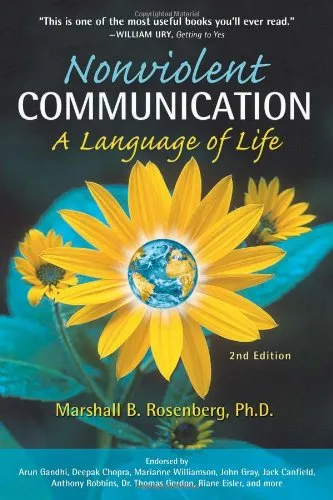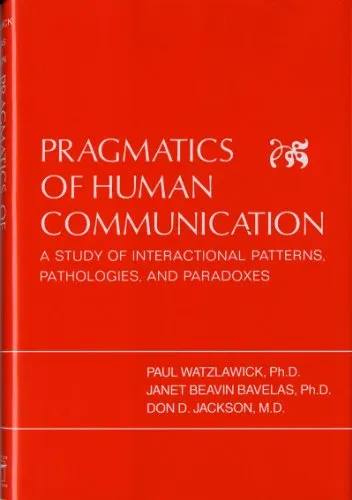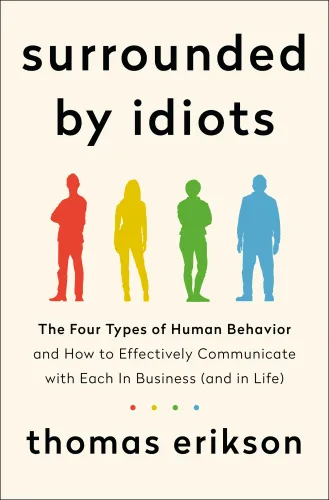Nonviolent Communication: A Language of Life: Create Your Life, Your Relationships, and Your World in Harmony with Your Values
4.8
بر اساس نظر کاربران

شما میتونید سوالاتتون در باره کتاب رو از هوش مصنوعیش بعد از ورود بپرسید
هر دانلود یا پرسش از هوش مصنوعی 2 امتیاز لازم دارد، برای بدست آوردن امتیاز رایگان، به صفحه ی راهنمای امتیازات سر بزنید و یک سری کار ارزشمند انجام بدینکتاب های مرتبط:
کتاب "ارتباط بدون خشونت: زبانی برای زندگی" نوشته مارشال بی. روزنبرگ یکی از آثار مهم در زمینه بهبود ارتباطات انسانی و ایجاد ارتباطات سازنده و همدلانه است. در این کتاب، نویسنده به بررسی روشهایی میپردازد که میتواند به انسانها کمک کند تا ارتباطاتشان با یکدیگر را بهبود بخشیده و به دور از خشونت و سوءتفاهم باشند.
خلاصهی تفصیلی کتاب
کتاب "ارتباط بدون خشونت" با معرفی چهار عنصر اصلی Nonviolent Communication آغاز میشود که شامل مشاهده، احساس، نیاز و درخواست است. نویسنده توضیح میدهد که چطور با توجه به این عناصر میتوانیم از قضاوتها و واکنشهای تهاجمی فاصله بگیریم و به درک بهتری از دیگران برسیم.
یکی از نکات برجسته کتاب، تأکید بر اهمیت گوش دادن همدلانه است. روزنبرگ به ما نشان میدهد که چگونه میتوانیم به جای فرضیات و پیشداوریها، به واقعیات و احساسات توجه کنیم. او بیان میکند که این نوع ارتباط نه تنها به درک بهتر دیگران کمک میکند، بلکه به تقویت روابط و ایجاد حس اعتماد و همدلی منجر میشود.
یادگیری های کلیدی
- تقویت توانایی مشاهده بدون قضاوت
- شناسایی و بیان احساسات به صورت صریح و واضح
- شناسایی نیازهای اساسی انسانی که در هر ارتباط مطرح هستند
- آموزش درخواستهای شفافی که مبتنی بر نیازها هستند
نقلقولهای معروف از کتاب
"شناخت ظرفیتهای محدود ارتباط خود و دیگران، اولین قدم به سوی ارتباط سازندهتر است."
"زبان عاطفی ما، قدرتی است که میتواند قلبها را به هم بیاورد یا آنها را از هم دور کند."
چرا این کتاب اهمیت دارد
در دنیای معاصر که ارتباطات انسانها بیش از هر زمان دیگری پیچیده و چندلایه شدهاند، فهم و استفاده از مهارتهای ارتباطی مؤثر ضروری است. کتاب "ارتباط بدون خشونت" ابزارهای عملی و روشهای مؤثری را ارائه میدهد که میتوانند به ما کمک کنند تا در ارتباط با دیگران، تفاهم و همکاری بیشتری داشته باشیم.
به طور کلی، این کتاب نه تنها برای کسانی که به دنبال بهبود روابط شخصی خود هستند، بلکه برای معلمین، روانشناسان، مشاوران خانواده و هر کسی که در حرفههایی کار میکند که به ارتباطات انسانی مرتبط است، اهمیت بسزایی دارد.
Introduction to Nonviolent Communication
Marshall B. Rosenberg's "Nonviolent Communication: A Language of Life" is an invitation to discover how compassionate communication can transform relationships, fuel personal growth, and cultivate a societal dialogue grounded in mutual respect and understanding. This foundational book introduces readers to a simple, yet profoundly impactful, approach to engaging with others.
Detailed Summary of the Book
At the heart of Nonviolent Communication (NVC) is the belief that everyone possesses the capacity for compassion and that when this capacity is nurtured, positive change occurs at a personal, relational, and societal scale. Rosenberg outlines a four-step process that helps individuals express themselves clearly and empathize more effectively: observation, feelings, needs, and requests. These steps aim to help individuals identify their own needs and the corresponding feelings that arise from these needs, while fostering an understanding of others’ needs and feelings.
The book emphasizes the critical role of presence and active listening in building connections. By focusing on the present moment without judgment, individuals can create a space of empathetic engagement. Rosenberg provides a wealth of practical exercises and illustrative examples to demonstrate how this approach can be applied in everyday interactions ranging from domestic conversations to resolving conflicts in professional and global contexts.
Key Takeaways
Nonviolent Communication is more than just a technique; it is a philosophy of living with authenticity and empathy.
- Observations vs. Evaluations: Clearly distinguish between what you see and your interpretations or judgments. This clarity prevents misunderstandings and paves the way for mutual understanding.
- Feelings vs. Thoughts: Learn to identify and articulate your feelings rather than disguising them with thoughts or interpretations about others.
- Needs vs. Strategies: Understand and communicate the underlying needs behind emotions. Differentiating needs from strategies fosters an openness to collaborative problem-solving.
- Requests vs. Demands: Frame your needs as requests instead of demands to encourage dialogue and freedom from obligation.
Famous Quotes from the Book
"Every criticism, judgment, diagnosis, and expression of anger is the tragic expression of an unmet need."
"Empathy allows us to re-perceive our world in a new way and move forward."
"When we hear the other person’s feelings and needs, we recognize our common humanity."
Why This Book Matters
The significance of "Nonviolent Communication: A Language of Life" lies in its transformative potential. In a world rife with conflict and division, this book offers a pathway to understanding, resolving differences, and cultivating cultures of peace and cooperation. Its practical applications are boundless — impacting personal relationships, educational systems, business environments, and international relations.
Rosenberg's approach empowers individuals to express and meet their own needs while also considering the needs of others, crafting solutions that serve the collective well-being. His emphasis on empathic engagement fosters deeper human connections and satisfies the universal craving for empathetic interaction. As readers incorporate these practices into their lives, they find themselves contributing meaningfully to the creation of a more compassionate world.
دانلود رایگان مستقیم
شما میتونید سوالاتتون در باره کتاب رو از هوش مصنوعیش بعد از ورود بپرسید
دسترسی به کتابها از طریق پلتفرمهای قانونی و کتابخانههای عمومی نه تنها از حقوق نویسندگان و ناشران حمایت میکند، بلکه به پایداری فرهنگ کتابخوانی نیز کمک میرساند. پیش از دانلود، لحظهای به بررسی این گزینهها فکر کنید.
این کتاب رو در پلتفرم های دیگه ببینید
WorldCat به شما کمک میکنه تا کتاب ها رو در کتابخانه های سراسر دنیا پیدا کنید
امتیازها، نظرات تخصصی و صحبت ها درباره کتاب را در Goodreads ببینید
کتابهای کمیاب یا دست دوم را در AbeBooks پیدا کنید و بخرید
1466
بازدید4.8
امتیاز0
نظر98%
رضایتنظرات:
4.8
بر اساس 0 نظر کاربران
Questions & Answers
Ask questions about this book or help others by answering
No questions yet. Be the first to ask!







